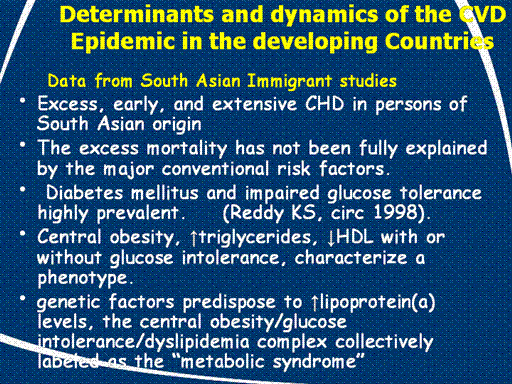| front |1 |2 |3 |4 |5 |6 |7 |8 |9 |10 |11 |12 |13 |14 |15 |16 |17 |18 |19 |20 |21 |22 |23 |24 |25 |26 |27 |28 |29 |30 |31 |32 |33 |34 |35 |36 |37 |38 |39 |40 |41 |review |
 |
Several studies around the
world have consistently revealed excess, early, and extensive CHD
in persons of South Asian origin. The excess mortality has not been
fully explained by the major conventional risk factors in
cross-sectional comparisons with other population groups. Diabetes
mellitus and impaired glucose tolerance are, however, highly prevalent
in South Asian migrants. Central obesity, high levels of triglycerides,
and low levels of HDL cholesterol, with or without glucose intolerance,
seem to characterize a phenotype frequently noted among South Asian
migrants.
Thus, South Asians in
urban and migrant environments may be at a higher risk of CHD due to
the confluence of (1) genetic factors that predispose to higher
lipoprotein(a) levels, the central obesity/glucose intolerance/dyslipidemia
complex collectively labeled as the "metabolic syndrome," and a possible
"thrifty gene" effect with (2) environmental influences that lead to
weight gain, rise in plasma cholesterol and blood pressure levels, and,
as yet inadequately studied, probable psychosocial risk factors
|